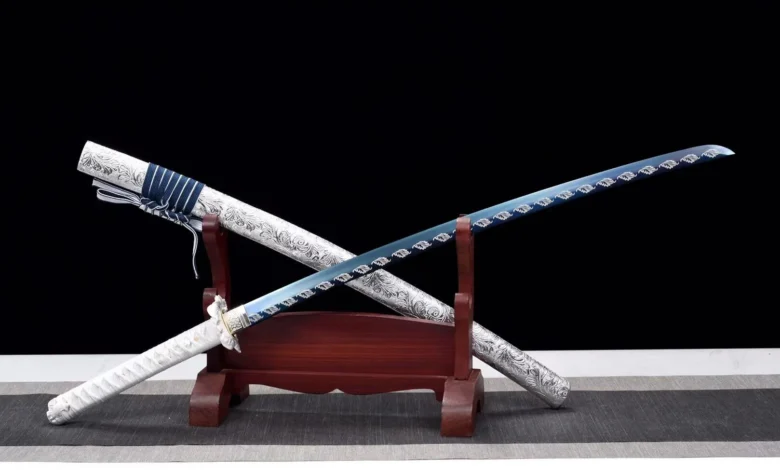The Real Japanese Katana: A Masterpiece of Samurai Tradition

The Japanese katana is one of the most iconic weapons in history, symbolizing the strength, honor, and craftsmanship of the samurai. With its razor-sharp blade, curved design, and cultural significance, the katana has captured the fascination of collectors, martial artists, and historians worldwide. In this article, we will explore the history, craftsmanship, and legacy of the real Japanese katana, as well as its connection to the legendary Japanese samurai sword.
The Origins of the Japanese Katana
The katana’s origins can be traced back to the Heian period (794-1185), when Japanese blacksmiths began crafting curved blades to suit the needs of samurai warriors. Unlike earlier straight swords, the curved katana allowed for faster and more efficient draws in combat, a crucial advantage in close-quarters encounters. By the Kamakura period (1185-1333), the katana had become the weapon of choice for samurai, solidifying its place in Japanese history.
The Craftsmanship Behind the Real Japanese Katana
Creating a real Japanese katana is a painstaking process that requires unparalleled skill and dedication. Traditional swordsmiths follow methods passed down for generations, ensuring each katana is a true masterpiece. The process includes:
1. Selecting the Steel
The katana is traditionally made from tamahagane, a high-quality steel produced by smelting iron sand in a tatara (a traditional Japanese furnace). This steel is prized for its purity and durability.
2. Folding the Steel
The steel is heated, hammered, and folded multiple times to remove impurities and create a blade with exceptional strength and flexibility. This folding process also results in the blade’s distinct grain pattern, a hallmark of a genuine Japanese katana.
3. Shaping and Curving the Blade
The blade is forged into its iconic curved shape through meticulous hammering and quenching. The curvature is achieved by cooling the edge of the blade faster than the spine, resulting in a sharp, resilient cutting edge.
4. Polishing and Finishing
Polishing a katana is an art in itself, requiring weeks of effort to achieve a mirror-like finish. This step enhances the blade’s sharpness and reveals the hamon, a unique wavy pattern formed during the tempering process.
The Japanese Samurai Sword: A Symbol of Honor
The katana is not merely a weapon; it is a symbol of the samurai’s code of ethics, known as bushido. This code emphasizes loyalty, honor, and discipline, values that the samurai upheld both on and off the battlefield. A samurai’s sword was considered their soul, representing their identity and status.
The Daisho Pair
Japanese samurai sword often carried a daisho, a pair of swords consisting of a katana (long sword) and a wakizashi (short sword). The katana was used in battle, while the wakizashi served as a backup weapon or for ceremonial purposes. Together, these swords signified the wearer’s rank and adherence to bushido.
Modern Uses of the Japanese Katana
Today, the real Japanese katana continues to captivate people around the globe. While it is no longer used in combat, it holds immense cultural and historical significance. Modern applications include:
1. Martial Arts
The katana remains an essential part of traditional Japanese martial arts such as kendo, iaido, and kenjutsu. Practitioners use it to learn discipline, focus, and the art of swordsmanship.
2. Collecting and Display
Collectors and enthusiasts seek authentic Japanese katana for their exquisite craftsmanship and historical value. Owning a genuine katana is akin to possessing a piece of art.
3. Pop Culture
The katana’s mystique has been immortalized in movies, anime, and video games. It has become a symbol of Japanese heritage, often associated with warriors and heroes.
How to Identify a Real Japanese Katana
With the popularity of the katana, many replicas and mass-produced versions are available. However, identifying a real Japanese katana requires knowledge of its distinguishing features:
1. Authentic Tamahagane Steel
A genuine katana is made from tamahagane steel, which gives it unparalleled strength and a distinctive grain pattern.
2. Handcrafted Process
Authentic katana are handcrafted by skilled artisans, ensuring no two blades are identical.
3. Signature (Mei)
Traditional katana often bear the swordsmith’s signature, known as a mei, engraved on the tang. This signature is a mark of authenticity and lineage.
Preserving the Legacy of the Katana
Efforts to preserve the art of Japanese swordsmithing are ongoing. Organizations and craftsmen in Japan continue to create authentic katana using traditional methods, ensuring this cultural treasure endures for future generations. Additionally, Japanese laws strictly regulate the production and sale of katana, maintaining their quality and authenticity.
Conclusion
The real Japanese katana and the legendary Japanese samurai sword are more than just weapons; they are embodiments of Japan’s rich history, culture, and artistry. From their origins on the battlefield to their modern-day significance, the katana remains a symbol of honor, precision, and beauty. Whether you are a martial artist, collector, or enthusiast, the allure of the katana is undeniable, making it a timeless treasure that continues to inspire awe around the world.




